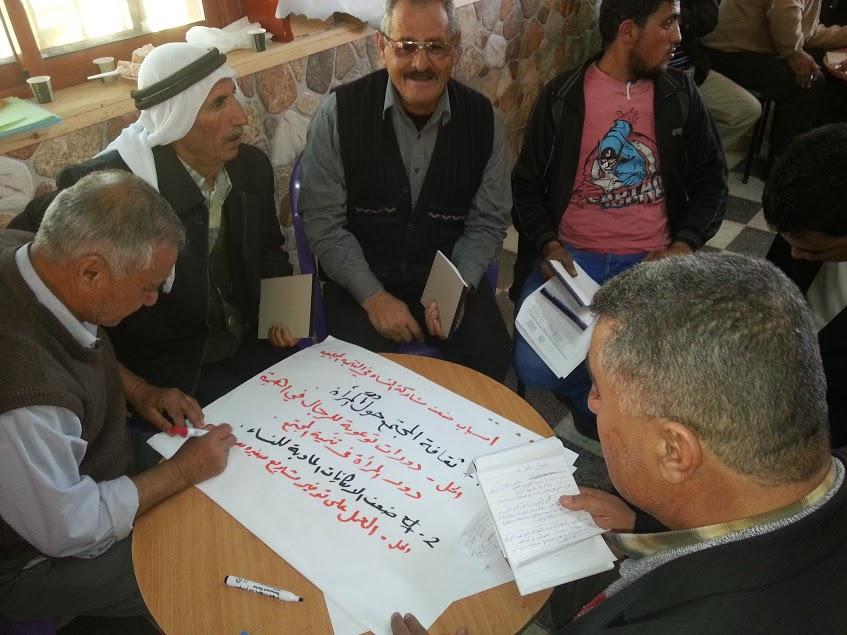Communication as a tool for strengthening local governance
Villages and Municipalities are the oldest
existing level of public authority in Palestine. They even have been, in some
periods of the Palestinian history, the only operational level of
administration. Villages are the main social anchorage of citizens and a true
witness of the Palestinian culture and identity. Still it seems that citizens
don’t always realize the importance and the role of Local Government Units in
the Palestinian governance and administration system.
The Palestinian Authority’s mission in the
field of Local Governance is defined as “to promote capacity and efficiency of
LGUs, enabling them to provide high quality and cost-effective services to
citizens at the local level through phased decentralization. Local Government
Units will be enabled to exercise their role, carry out assigned tasks and
obtain entitlements in accordance with provisions of the law.”
The Local Government Reform & Development
Program, funded by the Belgian Government, is acting upon this mission
statement by striving for small village clustering and inter-village
collaboration, local economic development, territorial integration and policy
making. To a smaller extent the program also focuses on community
participation as the communication plans of the village clusters may be
considered as a first step in this direction. Through communication, attention is
given to awareness raising, creating citizenship[1],
sharing a vision and community participation.
Communication is a participatory process
A healthy society can only be achieved through an effective and interactive communication. This means a two-way process in which information, knowledge and skills relevant for local government development are exchanged between stakeholders and community members. Indeed, local governance refers to a public action which is “concerted” through a strong participation and a close coordination of all stakeholders in designing, implementing and monitoring public policies and (development) projects. As such, communication is to be considered as a crucial and intrinsic tool in all governance processes and especially in a decentralized institutional framework.Communication allows to achieve different but complementary objectives and results: to inform citizens and raise their awareness on public issues which leads to understanding; to create a same vision which will boost cultural and socio-economic initiatives; and to organize participation (partnerships) amongst stakeholders to create citizenship and commitment.
Communication is as such used for people’s participation and community mobilization, decision making and action, confidence building for awareness raising, sharing knowledge, and changing attitudes, behavior and lifestyle.[2]
The role of LGUs in communicating towards creating citizenship
When people of all ages, abilities, and socio-economic backgrounds can not only access and enjoy a place (cluster of villages), but also play a key role in its identity, creation and maintenance, only then we achieved sustainable and effective village clustering. An effective agglomeration process as such, capitalizes on local community’s assets, inspiration, and potential, and it results in the creation of a community that contributes to people’s health, happiness and well-being.The LGUs are the key actors in enabling a good environment for (local) development. They tackle political, social, economic and cultural matters in order to create a good living environment for the citizens. However, they cannot provide development by themselves: they need a strong dialogue with different members of the society; both shareholders – who strive for the same goals – and citizens – the beneficiaries – in order to address the communities’ needs. As such development is no longer a one-way matter (strived for by one single actor or agency), but is rather a dialogue between different partners, where all partners cooperate to achieve a shared vision and goal.
In order to enhance the role of LGUs in implementing development projects in local communities, the partnership between the Joint Service Council (JSC), the private sector and community-based organizations should be strengthened. This cooperation will imply sustainable development and promote the principle of social responsibility taken by all actors.
No communication without monitoring and evaluation
Participatory communication articulates social change processes. As such, the evaluation should not focus purely on outputs, but rather on the satisfaction of the people. Furthermore, if participation means that stakeholders are partners in the entire process, it means they should also be involved in the monitoring and evaluation phase of a project.A participatory M&E is a social process which is not a set of techniques to get to know what you want to know, but is more importantly an opportunity for people to express their views, needs and expectations. Also in LGRDP we support an ‘appreciative’ M&E approach through which we want to ask the citizens to examine their present community and living environment, to appoint the assets of the cluster and the inter-village arrangements and to define their community for 2025.
A participatory M&E is no longer a tick list, but becomes a true communication tool. Furthermore, this ‘positive’ approach results in making the community feel proud and positive about their community and their role in this community. The process also leads the community towards transparency, mutual trust, partnering and community institution building. As such, this participatory M&E not only monitors the project, but also enhances the communication, institution building and empowerment which are part of the outcomes of any development project, including LGRDP.
In conclusion
The idea of participatory communication has considerably gained attention in recent years. Many development agencies and other actors in the field believe that they have found in participatory communication the most appropriate concept to guide their work in the developing world. However it is a concept that is challenging to implement. Leadership and management are skills that are crucial. Proper application of participatory communication methods are not enough to ensure a project’s success as an enabling context (with stakeholders at local and national level having an enabling attitude) is as important.LGRDP wants to join the fray of participatory communication. The program supports the LGUs’ staff through concessive capacity building activities, in order to enable them to develop and implement a participatory communication strategy. So far, communication plans have been developed in a participatory way, but now, we want to go a step further. Revising the approach, together with the four communication officers of the targeted clusters, is a first step in the right direction. Conducting a participatory M&E of the program is a second. Both together will give us insight in how to optimize the communication strategies at LGU level and how to work together towards sustainable community development, including all outputs of the program; strong local governance, citizenship, territorial integration, etc.
Communication in LGRDP
In an overall challenging socio-political context, local government is seen by the Palestinian Authority and the government of Belgium as a driving force for promoting both State building and local economic development. Since 2001, Belgium supports Palestine towards facilitating and strengthening collaboration between LGUs, with a particular focus on the smaller local Authorities, through the Local Government Reform and Development Program (LGRDP).LGU collaboration through Joint Service Councils is seen as the entry point for capacity building of LGUs to improve their service provision, promote local economic development and contribute to territorial integration. In a first phase LGRDP focused on infrastructural projects such as linking roads in order to physically link the different villages in one cluster. In a second phase also social infrastructural projects were implemented such as women centers, health clinics, etc. All these infrastructural projects enabled inter-village collaboration. But to ensure a good connection between the different communities of the clusters, social activities were essential.
Therefore community participation was, since the early beginning of LGRDP – by now 6 years ago – acknowledged as a crucial aspect of LGU planning and development. A first approach was to contract an external consultant to develop the communication plans of the targeted clusters. Gradually, the approach shifted towards empowering and enabling the staff of the JSC to develop their own plans. Since 2014, LGRDP (financially) supports a communication officer in each of the clusters who is part of the JSC’s staff and fully responsible of all local communication, including the development of the yearly communication plans.
Communication plans consist out of different communication activities that reflect an integrated view on the LG reform process. Moreover, also by inviting all community groups, community leaders and CBOs to participate in the development of the communication plan, the JSC encourages inclusion, sharing visions and general participation. Approximately every month a communication activity, such as “Planting trees”, “Cleaning Day”, “Ramadan Iftar”, is organized.
[1] Citizenship means people think of themselves as active citizens, willing and able to have an influence in public life and their local communities. [2] M.O. Adedoku, C.W. Adeyemo and E.O. Olorunsda; The impact of communication on community development; Kamla-Raj, 2010
Latest news from this project
No news

